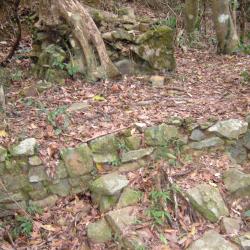The Chushuipo Shrine is located west of Chushuipuo police post. There are stone steps on the side of the road, and along the steps, about 100 meters away are the remains of the shrine. Its foundation is about 4.7 meters square, about 0.6 meters high, and there are three stone steps of 0.8 wide in the front. In the center is the base of the shrine, which is 1.3 meters square and 0.5 meters high. The torii that once stood on both sides of the steps have decayed, and only two pillar holes remain.
paiwan
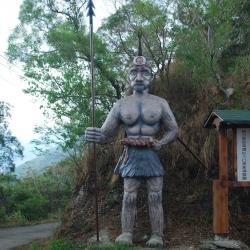
After passing through the small Lili hamlet on the Dahan Forest Road it goes downhill slightly and soon you can see a tall statue of the Paiwan Warrior on the right. This is the entrance of the old Lili hamlet and an important intersection for the Paiwan people in the past. Standing on the ridge line, there is the industrial road leading to the old Lili hamlet in the north, and to the ruins of Guhuashe in the south. The old Lili hamlet is divided into two tribes. The bigger tribe in the north is called Kinajian, while the smaller tribe in the south is called Contres. Lili hamlet and Guhua hamlet were allies, and often joined forces to fight against foreign rulers of the Dutch, Qing, or Japanese eras. How many times they were conquered, killed, and their villages burned, they never changed their firm belief and the idea of independence.
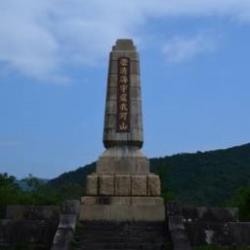
The Shimen Historic Battlefield is located at the junction of Checheng Township and Mudan Township in Pingtung County, in the hilly and mountainous areas of the Sichong River and its tributaries. Since the Mudan incident, the Japanese have been calling the place Shimen. In the post-war period, the village and township was named after it.
As a fact, the former Monument of Commander Saigo Judo and the Monument of the Loyal Soul (in memory of the Japanese soldiers who were killed in the battle between indigenous peoples) were built to commemorate the Mudan Incident. In the post-war period, the monuments were deemed a humiliation to the country, and thus the words on the monument were replaced to commend the anti-Japanese spirit of the indigenous peoples.
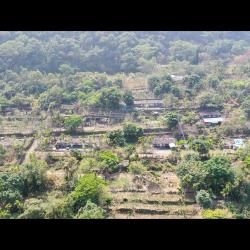
The old Dalai Hamlet in Sandimen Township, Pingtung County, is located on the left bank of Ailiao North River. In the beginning of 1937, the Government-General in Taiwan began the relocation project. The hamlet was relocated collectively at the end of the Japanese occupation. Village residents participated in this labor work and manually leveled land building the police post and education center. The slate materials were transported from Talatalai Hamlet to the old Dalai Hamlet. It took about 5 hours on foot between the two hamlets and finally after the joint effort of the people, the relocation was complete in 1941. The village is organized into a chessboard pattern, with the police station and education center located on higher ground for easy surveillance.
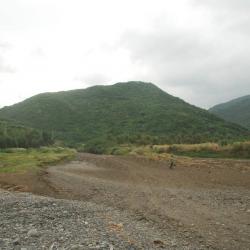
Nureng River that flows through to the Xuhai end of the Hengchun Beinan Historic Trail is located in Mudan Township in Pingtung County. As rainfall happens in summer, the river turns into a low current in winter and becomes a barren stream. The Hengchun Beinan Historic Trail, which crosses Hengchun Township in Pingtung County and Taitung City in Taitung County, runs northward along the coast from Hengchun through Manzhou, joining other trails in Pingtung, and then arriving at Taitung City. In the middle of the Japanese occupation period, the Hengchun Beinan Historic Trail had long been widened as a designated road for cars. Therefore, the remainder of the trail that we see today are mostly roads for cars during the Japanese occupation. Currently the impassable section of the road is in the Guanyinbi area.
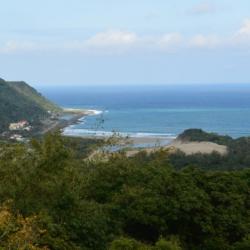
Bayao Bay is located on the east coast of the Hengchun Peninsula in Manzhou Township, Pingtung County. It is a historical site for the Mudan incident that happened during the Qing period. At that time, the ship Yamahara voyaged from Miyako Island of Ryukyu to Naha to pay the annual tribute. On its return it got blown off course, hit by a typhoon and shipwrecked off the southeastern coast near Bayao Bay. After the sailors on board landed, they were killed by the Paiwan people of the neighboring Gaoshifuoshe. Ryukyu Kingdom was at that time in the sphere of Japanese influence and therefore, Japan used this incident as an excuse to attack Taiwan and the indigenous people in 1874, and eventually annex Ryukyu Kingdom in 1879. This Mudan incident was a wake-up call for the Qing government and they began to actively manage the Hengchun Peninsula, and the Taiwanese policy also changed drastically.
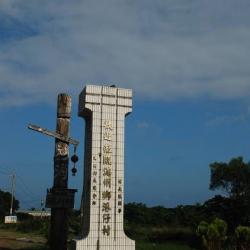
Gangzai Village is located at the northernmost of the Manzhou Township in Pingtung County. It is almost mountainous. The riverbanks of Gangzai River and its tributary Jiaoxi, as well as the river valley plain where the stream flows into the ocean are the main farmland for the whole village. In the past, Gangzai Village was the traditional territory of the Gaoshifuoshe of Paiwan ethnic group. Later, Amis people from the Hengchun area also settled here. The village used to be a passing point on the Langjiao Beinan Historic Trail, but today it has been rebuilt as the end of County Road 200, which is remote and inconvenient for transportation.
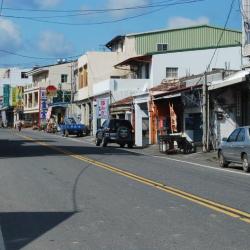
Manzhou Village is located in the basin of Gangkou River and its tributary Laofo River in Manzhou Township, Pingtung County. In the past, it was the traditional hunting ground for the Wenshuai-Shandingshe of Paiwan ethnic group and the Zhusheng-sushe (Ciljasuak) of Seqalu ethnic group. Later, the Hakka immigrants came here to cultivate. During the Japanese occupation period, Taiwan’s Government-General set up villages, public schools, police posts, telecommunication offices, post offices, and other facilities here, making it the administrative center of Manzhou Township. In 1920, local system corrections were implemented and Wenshuai was re-named to Manzhou. However, as the two characters of “Manzhou” is the same as the Manzhou in north-eastern China, it got opposed by residents and was rewritten to the current name.
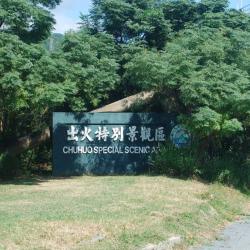
Chuhuo is located outside Hengchun East Gate in Hengchun Township, Pingtung County, and under the Erchongxi Bridge on the 3 km point on the northern side of County Road 200. It is a famous geological landscape in Hengchun Peninsula. The burst of fire on the ground surface is formed by the natural gas stored in the mudstone layer. However, since the location of the fire shifts, the locations of Chuhuo settlement and the Shanhuo bridge are not on the current scenic spots. In fact, the Chuhuo settlement was near Chuhuo Bridge because in the early days of the Japanese occupation, it was probably located on the Chuhuo Riverbank.
Nowadays, people live on the north side of the highway. Although there are not many households there, based on the sacrificial pot that was left there, the place was once inhabited by the Pingpu ethnic group, and was called Pingpufan Cuozhuang.
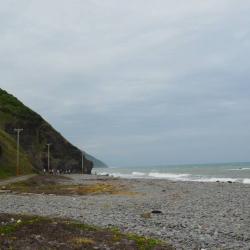
The Hengchun Beinan Historic Trail, which crosses Hengchun Township in Pingtung County and Taitung City in Taitung County, runs from Hengchun via Manzhou, passing through the end of the Central Mountain Range to reach the coast, and then passing through Xuhai and Guanyinbi. Continue walking north along the coast, you will pass by Nantian Hamlet and Anshuo Hamlet, joining other trails that leads to Pingtung, and finally arriving at Taitung City. In the middle of the Japanese occupation, the Hengchun Beinan Historic Trail had long been widened as a designated road for cars. Therefore, the remaining trails that we see today are mostly roads for cars during the Japanese occupation period. Currently the impassable section of the road is in the Guanyinbi area.
